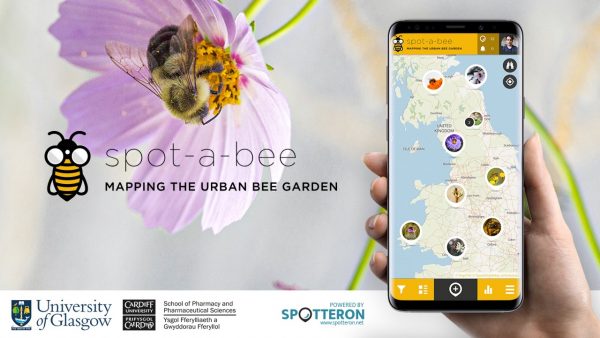Have you got the Spot-a-bee buzz?
27 July 2020
The next time you are in the garden or walking the dog, look out for bees. If you take a picture on your phone of the plants they visit, and share them on Spot-a-bee, you’ll be helping scientists in their quest for new antibiotics.

Here, Professor Les Baillie, School of Pharmacy and Pharmaceutical Sciences, explains how the app can drive innovation in drug discovery.
“Rather like a bee’s flight trajectory, the launch of Spot-a-bee has been a winding journey.
Originally, our #Pharmabees work began as an effort to identify novel antimicrobial compounds found in honey and to see if we could use them in the fight against hospital superbugs.
We screened over 250 samples of honey collected as part of a national survey for activity against hospital superbugs: then we identified the plants which were the source of the antimicrobial compounds found in individual honey samples by analysing the pollen found in the honey.

The next logical step was to begin growing the right pollinator plants at sites across Cardiff as part of an effort to produce our own antimicrobial honey.
To achieve this am we have combined the bee friendly, antibiotic plants identified from our research with other pollinator friendly plants to develop a wildflower seed ‘supermix’ which we have been distributing free of charge to inner city schools, community groups and members of the public across the Cardiff.
In addition to monitoring the growth of these plants, we are asking members of the public to record the pollinators which visit them using a new app we have produced called Spot-a-bee – which allows the public to map the bees friendly plants growing in their backyards, in city parks and by the roadside.

Gathering images and information sent in by the public will enable us to validate our wild flower seed mix and will generate much-needed data on the biodiversity of the flora and fauna in Cardiff and beyond in our quest to promote biodiversity and develop new antibiotics.
Since the launch of the app – a joint initiative with Dr Ria Dunkley at the University of Glasgow’s School of Education – in May, at the height of lockdown, more than 3,000 people have downloaded the app – and over 4,000 images of plants and bees taken by members of the public have been uploaded onto the site. We’ve had spotters from northern Scotland to Penzance joining us from home as they connect with others interested in bees and nature around the UK.
And while we have had approximately 150 submissions from Cardiff (as the screen grab image shows), we have received over 350 from the people of Monmouth – a town the fraction of the size!
Whilst it’s a great start, we need more information especially from the people of Cardiff !
It’s a great time to get involved. You can download the Spot-a-bee app from the Apple App Store or Google Play or, if you want to know more, get in touch via Twitter @ISpotABee, Instagram or Facebook – and join us in a backyard hunt for new antibiotics!”
Les Baillie, Professor of Microbiology, School of Pharmacy and Pharmaceutical Sciences